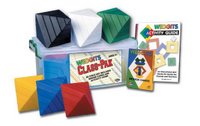 The Wedgits folks make a special "Class Pak" with six basic ("Junior") sets of 15 pieces each. All the different size or shape pieces in a set are the same color, and each of the six sets is in a different color.
The Wedgits folks make a special "Class Pak" with six basic ("Junior") sets of 15 pieces each. All the different size or shape pieces in a set are the same color, and each of the six sets is in a different color.This is quite a contrast to the regular sets, where no matter which set you get, the sizes are matched to their specific colors (WoW has different versions of the colors, but pretty much the same scheme). That means to build anything, you are largely obliged to mix all the colors in your structure. Which can create sensory overload for the autistic part of my brain.

The Class Pak is intended for classroom use, presumably helping the students sharing a workspace avoid sharing each others Wedgits.

But by using the full Class Pak, a lone builder can have every size or shape of basic Wedgit in each of six colors. Picking a limited palette can be not only easier on the eyes, but also create new aesthetic opportunities.
I usually combine the Class Pak with the regular Wedgits, which means that the count of Wedgits of different sizes varys depending on what colors are being used. Sometimes I use dice with the six colors on the faces to choose which colors to play with (you could use regular dice, and a simple number-to-color chart); duplicated colors in the dice roll means fewer colors in the play mix.
That should be fun. :)

[created 11/9/05; modified 5/13/07]




4 comments:
One of my projects for today is to pick up some color dice. These have a different color circle on each face: red, green, blue, yellow, purple, black. By changing purple to white, they will correspond to the colors of the wedgits.
Three dice will give three different colors 55.6% of the rolls, two colors 41.7%, and a single color 2.8% (rounded percentages).
That should provide for some interesting play.
=-=-=
I had never gotten around to measuring the Wedgits, since they are unlikely to be combined with anything else.
It was clear that they were about a one inch pitch, but when I measured them (yes, I thought of something else they could be used with), they turn out to be a "metric inch" of 25 mm, rather than our inch of 25.4 mm.
That makes sense, since they are based on a European original: "Diamant" by Naef Spielkultur of Switzerland.
So, I keep thinking ...
With six colors, there are 20 ways to have combinations of three colors ... 15 of two colors and 15 of four colors (same same -- four colors is all the ways two colors cna be left out, and vice versa) ... 6 of 1 color, 5 of 5 colors, 1 of all six. 62 different combinations altogether. :)
I've done some more three color play. This is going to be lots of fun. Have I mentioned that I have long liked playing with different color combinations? This is a new context, but it is the same old fun.
In "cool Tools" Kevin Kelly called Wedgits "3D Tangrams" ( http://www.kk.org/cooltools/archives/000931.php ).
How true - and that is more obvious when playing with a single color.
With multiple colors to choose from for each piece, Wedgits can also be a form of "3D Parquetry Tiles" ( http://blockplay.blogspot.com/2005/11/parquetry-blocks.html )
I had fun with the wedgits.
I don't like mixing colors. :)
Black & blue & a little green isn't mixing?
I wish I had taken a picture. :)
Are you saying you would have been happier if there had been enough Class Paks to allow multiple-set building just with pieces of a single color?
Which color would you choose?
Post a Comment